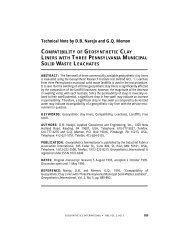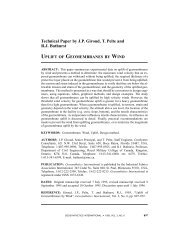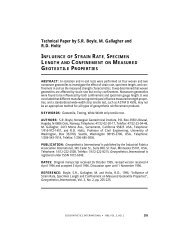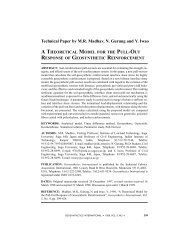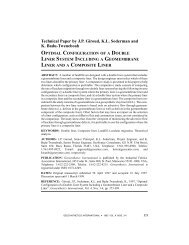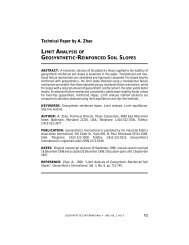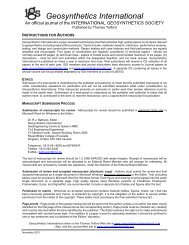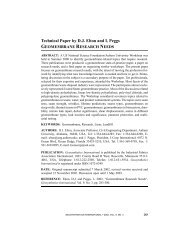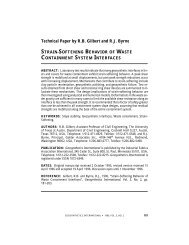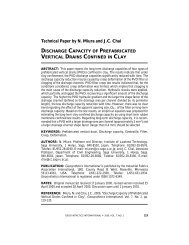Technical Paper by B.C. Rawes - IGS - International Geosynthetics ...
Technical Paper by B.C. Rawes - IGS - International Geosynthetics ...
Technical Paper by B.C. Rawes - IGS - International Geosynthetics ...
You also want an ePaper? Increase the reach of your titles
YUMPU automatically turns print PDFs into web optimized ePapers that Google loves.
RAWES D Parameters for Prefabricated Vertical Drain Specification<br />
Standard ASTM methods of test are chosen for quality control testing since they are<br />
the most widely used testing standards in the Far East where most PVDs are used. The<br />
standard ASTM D 4716 test is not, however, the best test method for a PVD. Unlike the<br />
Delft test and the NTU test, the ASTM D 4716 test is a standard code of practice, and<br />
therefore, testing laboratories will be more familiar with it. A specification requirement<br />
to use 6 mm thick closed-cell foam rubber between the clamps and the PVD in the the<br />
ASTM D 4716 test to better model the site situation is included in the model specification<br />
even though there is likely to be a variation between laboratories in the type of rubber<br />
used. For PVDs where the geotextile filter is not fixed to the core structure and loose<br />
geotextile filter material can easily be pushed into the core, unrealistically high discharge<br />
capacity results will be measured when steel platens are used without the foam<br />
rubber.<br />
9 SUMMARY<br />
The model PVD specification has been prepared in an effort to ensure that the engineer<br />
receives a quality PVD that should be acceptable while not eliminating the element<br />
of competition between suppliers.<br />
The PVD has two main components, a geotextile filter and a core structure. Only the<br />
geotextile is tested as a separate component (pore size and permeability), all other specified<br />
properties are for the complete PVD. The values presented in the model specification<br />
for geotextile pore size and permeability are easily achieved <strong>by</strong> all geotextile<br />
manufacturers and match current geotextile filter criteria. In particular, the maximum<br />
poresizeof75µm has been proven in practice to be effective. Since the wet sieving<br />
technique gives O 95 values 50% less than those obtained using a dry sieving technique<br />
(Bhatia et al. 1994), then the choice of a maximum geotextile pore size value of 75 µm<br />
is further reinforced.<br />
In carrying out a project, much attention is often paid to the material tensile strength.<br />
This may be due to the ease with which this test can be performed for comparison purposes,<br />
and in part due to manufacturers of higher strength PVDs who strongly promote<br />
the high tensile strength of their PVDs. As has been discussed, the tensile strength required<br />
for installation of a PVD is only 0.5 kN. When installing PVDs using installation<br />
rigs that are not of the highest standard (i.e. significant roller friction, and therefore, an<br />
increase in load on the PVD), a tensile strength specification of 1.0 kN will allow for<br />
the load increase in the PVD. It is considered important, in order to simulate site conditions<br />
as closely as possible, that the ASTM D 4595 wide-width strip test, modified to<br />
suit the actual width of the PVD and reported as the total load, is used to measure the<br />
tensile strength of PVDs. The ultimate strength of a PVD, which occurs beyond 10%<br />
strain, should not be considered in a PVD comparison since this is outside the maximum<br />
discharge performance of the PVD due to core distortion.<br />
The discharge capacity, q w , is one of the most important characteristics of a PVD, but<br />
unfortunately, it is the most difficult test to perform, and different laboratories may obtain<br />
varying results for the same PVD. It is believed that <strong>by</strong> using the ASTM D 4716<br />
standard test method together with closed-cell foam rubber between the clamps and the<br />
PVD, and careful attention paid to ensure laminar flow, that better agreement between<br />
laboratories could be achieved. It should be noted that a hydraulic gradient value is not<br />
62 GEOSYNTHETICS INTERNATIONAL S 1997, VOL. 4, NO. 1



